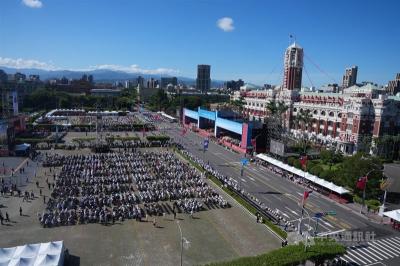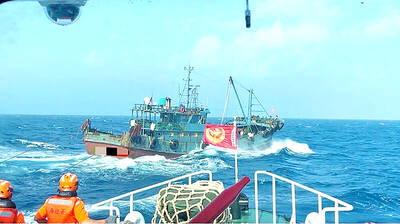The slump in China’s exports eased last month as industrial output and retail sales rose sharply, the government said yesterday, showing that recovery in the world’s third-largest economy was firmly on track.
Exports fell 13.8 percent last month to US$110.8 billion from the same month last year, the smallest decrease in 10 months, government figures showed. Imports dropped by 6.4 percent to US$86.8 billion over the same period, a slightly faster pace than in September.
Meanwhile, the key inflation rate, known as the consumer price index, was down 0.5 percent last month from the same month last year, the National Bureau of Statistics said.
Together, the monthly figures provide the latest evidence that China’s economy will meet or surpass the government’s goal of 8 percent economic growth for the full year.
Statistics Bureau spokesman Sheng Laiyun said retail sales were up a robust 16.2 percent last month from the same month last year, while industrial output rose 16.1 percent.
“The October data show that we have more reasons to believe the economy will achieve the goal of 8 percent growth,” Sheng told a news conference.
He said there were no inflation worries at the moment.
Fixed asset investment for the first 10 months of the year surged 33.1 percent compared with the year-ago period, Sheng said.
China has rebounded faster and stronger than other major economies from the world economic crisis, with flowing government spending and bank lending pushing up economic expansion by 8.9 percent in the third quarter.
“October’s figures came as no surprise. The momentum for an economic recovery carries on despite the fall of imports,” said Feng Yuming, a macroeconomic analyst for Oriental Securities in Shanghai.
Feng said the further decline in imports was the result of lower commodity prices.
The gush of lending has inflated China’s stock and real estate markets massively this year. However, Chinese banks curtailed new loans sharply last month, by more than 50 percent to 253 billion yuan (US$37 billion) compared to September, amid growing concerns the easy lending would create asset bubbles.
Companies, central bankers and political leaders around the world are increasingly counting on growing demand from Chinese producers and consumers to offset sluggish home markets. Much of China’s growth is coming from government-backed spending on construction and other projects, but demand from China’s traditionally frugal, still relatively poor consumers is also rising.
“The new good change in October is that the trend in the contribution of consumption to economic growth is increasing and we believe that in the fourth quarter it will increase,” Sheng said.

POLITICAL AGENDA: Beijing’s cross-strait Mid-Autumn Festival events are part of a ‘cultural united front’ aimed at promoting unification with Taiwan, academics said Local authorities in China have been inviting Taiwanese to participate in cross-strait Mid-Autumn Festival celebrations centered around ideals of “family and nation,” a move Taiwanese academics said politicizes the holiday to promote the idea of “one family” across the Taiwan Strait. Sources said that China’s Fujian Provincial Government is organizing about 20 cross-strait-themed events in cities including Quanzhou, Nanping, Sanming and Zhangzhou. In Zhangzhou, a festival scheduled for Wednesday is to showcase Minnan-language songs and budaixi (布袋戲) glove puppetry to highlight cultural similarities between Taiwan and the region. Elsewhere, Jiangsu Province is hosting more than 10 similar celebrations in Taizhou, Changzhou, Suzhou,

The Republic of China (ROC) is celebrating its 114th Double Ten National Day today, featuring military parades and a variety of performances and speeches in front of the Presidential Office in Taipei. The Taiwan Taiko Association opened the celebrations with a 100-drummer performance, including young percussionists. As per tradition, an air force Mirage 2000 fighter jet flew over the Presidential Office as a part of the performance. The Honor Guards of the ROC and its marching band also heralded in a military parade. Students from Taichung's Shin Min High School then followed with a colorful performance using floral imagery to represent Taiwan's alternate name

COGNITIVE WARFARE: Chinese fishing boats transmitting fake identification signals are meant to test Taiwan’s responses to different kinds of perceived incursions, a report said Chinese vessels are transmitting fake signals in Taiwan’s waters as a form of cognitive warfare, testing Taipei’s responses to various types of incursions, a report by the Institute for the Study of War said on Friday. Several Chinese fishing vessels transmitted fake automatic identification system (AIS) signals in Taiwan’s waters last month, with one mimicking a Russian warship and another impersonating a Chinese law enforcement vessel, the report said. Citing data from Starboard Maritime Intelligence, the report said that throughout August and last month, the Chinese fishing boat Minshiyu 06718 (閩獅漁06718) sailed through the Taiwan Strait while intermittently transmitting its own AIS

CHINESE INFILTRATION: Medical logistics is a lifeline during wartime and the reported CCP links of a major logistics company present a national security threat, an expert said The government would bolster its security check system to prevent China from infiltrating the nation’s medical cold chain, a national security official said yesterday. The official, who wished to stay anonymous, made the remarks after the Chinese-language magazine Mirror Media (鏡周刊) reported that Pharma Logistics (嘉里醫藥物流) is in charge of the medical logistics of about half of the nation’s major hospitals, including National Taiwan University Hospital and Taipei Veterans General Hospital. The company’s parent, Kerry TJ Logistics Co (嘉里大榮物流), is associated with the National Committee of the Chinese People’s Political Consultative Conference (CPPCC) and the Chinese People’s Liberation Army (PLA), the